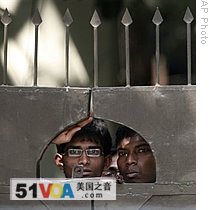New Delhi
27 February 2009
Tanks rolled unchallenged into the headquarters of the Bangladesh Rifles Friday as government officials, soldiers and police began surveying a scene of carnage in wake of a two-day mutiny that may have left more 100 people dead, mostly Army officers. Security forces have arrested about 300 members of the paramilitary border guard which revolted. The situation remains tense with emotions running high in the army over the loss of so many officers.
 |
| Local residence peep through the gate of their house near the Bangladesh Rifles headquarters in Dhaka, Bangladesh, 26 Feb 2009 |
A survivor told reporters he witnessed the deaths of many of his fellow Army officers when 2,000 border guards opened fire on their commanders. The Lieutenant Colonel, Syed Kamruzzaman, says among the dead are the chief of the Bangladesh Rifles, Major General Shakil Ahmed.
Some of the uniformed bodies have been found dumped in sewers outside the guards' barracks. Several civilians are also reported to be among the dead.
During the mutiny, some of the guards said the uprising was triggered by the Army leadership ignoring their grievances. The paramilitary force has long resented that its leadership comes from the Army, not its own ranks. There have been complaints of officers skimming funds while the relatively meager salaries of the guards have not keep pace with soaring food prices.
The rebels put down their weapons after Prime Minister Sheikh Hasina negotiated with them and made a nationally televised appeal Thursday, saying in exchange for surrender she would address their concerns and grant amnesty to mutineers.
But with details emerging of the massacre that took place at the Bangladesh Rifles' headquarters, retired major general A.N.M Muniruzzaman, president of the Bangladesh Institute for Peace and Security Studies, expects the perpetrators to face justice.
"The figures could go as high as 100 to 120 [killed]," he said. "Besides, there has been extensive looting, burnings of buildings inside, alleged instances of physical abuse and rape. ?I don't really think that this should be pardoned."
The paramilitary force, which has tens of thousands of soldiers in more than 60 posts nationwide, is primarily tasked with patrolling Bangladesh's four-thousand kilometer-long border with India. But it is also used as an auxiliary force to assist the army and police during times of unrest.
Retired General Muniruzzaman, a former presidential chief of staff, says the command structure of the Bangladesh Rifles, known as the BDR, has been destroyed by the mutiny.
"This is a major challenge that the government will have to face now. Because, as of today, I understand our borders are unguarded," he said. "Most of the battalions located on the borders are not performing their duties. Complete chain of command of the BDR has been physically wiped out."
The BDR traces it roots to the late 18th century when it was formed by colonial British rulers. It has a heroic legacy in modern Bangladesh because most of its troops revolted against their Pakistani masters during the 1971 war of independence.
Since independence, Bangladesh has seen a series of violent military takeovers and attempted coups.